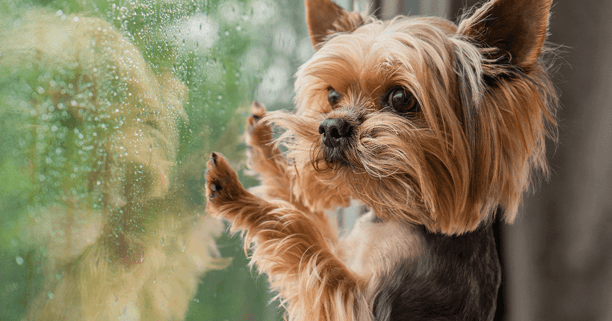Back-to-school is always a time of transition for the whole family. And even more so after the long summer breaks. For many, the sudden change of being with their family all the time to spending more time alone can trigger nervousness, frustration or even separation anxiety in dogs.
Our dogs can find this period of time difficult as their routine changes and they have less social contact throughout the day. But the adjustments don’t stop there. They may also be more used to the increase in exercise or time outdoors that comes with the summer months.
If you notice during these times that your dog is nervous, or showing signs of separation-related nervousness, the best thing to do is come up with a plan of action. Once you have tried and tested a routine, you can then repeat this habitually when the time of year arises. This will also help to make things easier each time you’re leaving your dog home alone while at work.
Signs that can indicate your dog has separation anxiety:
- Change in appetite
- Pacing
- Barking
- Whining
- Lethargy
- Chewing
These types of body language can vary from dog to dog. So if you’re unsure, it’s always best to consult your vet.
Solutions for leaving your dog at home alone
As the days slowly, but surely, start to get shorter and the hot temperatures cool down, it’s time for the return back to school. For guidance with leaving your dog home alone, follow our top tips below!
Tip 1: Introduce Time Alone Slowly
Routines are what help provide our dogs with reassurance. And in the cases where you’re leaving your dog home alone, this is important, more than ever for their behaviour. Start to make the changes gradually a couple of weeks beforehand. This may also help the family as a whole prepare for stressful transitions!

Tip 2: Slowly Ease Into A Routine
Another key solution for leaving your dog at home is to ensure you get them accustomed to being alone. Puppies, for example, will need more training for this as they will not be used to spending time alone. As a result, they often struggle to adjust. You can start to introduce the time they spend alone bit by bit, building up the time apart as they ease into the process. Of course, go at the pace of your own dog. Some may find it easier to settle into this than others.

Tip 3: Keep Their Exercise Levels Up
As the saying goes, exercise is key! Whether you come home on lunch breaks, ask a friend to walk your dog or hire a dog walker, it’s still important they maintain a good level of exercise. If you don’t already, try including your dog on the walk to school or even just to the bus stop. Any opportunity, large or small, to get your dog outside and be in the presence of people will always benefit your pooch.

Tip 4: Be Low Key
When leaving your dog home alone, don’t make the times you leave them too high in energy. Making too much fuss can cause the opposite effect on your dog. Especially if you know this makes your dog nervous, so try to remain calm and stay low key.

Tip 5: Try A Calming Diffuser For Dogs
Calming diffusers for dogs are an ideal solution for when leaving your dog at home. ADAPTIL Calm home diffusers help to create a reassuring environment in the room your pup spends most of their time in. These provide comfort for your dog when spending time at home alone.
Note* Make sure your dog has a place that they feel safe to rest in and be undisturbed. Then plug in the ADAPTIL dog calming diffuser in this area.
Tip 6: Look At Other Alternatives
If your dog is showing signs of not coping well with being on their own, even after you’ve tried to adapt them into a routine, consider alternatives. These could include doggy daycare, dog walkers, sitters, or maybe taking your dog to work (if able and safe to do so).
Or perhaps your pooch would enjoy some back to school time too! Consider signing up for some puppy training classes, agility classes or socialization groups to help you learn something new together.

ADAPTIL – Helping Nervous Dogs Stay Calm
We want all anxious and nervous dogs to feel calm at ADAPTIL. Which is why, we have specially designed our products to help give them that extra support for challenging situations. Our calming dog diffusers are free from any harsh fragrances or chemicals, and made using calming messages that replicate their mothers pheromones. Trusted worldwide, you can count on ADAPTIL for both expert guidance for pet parents and to deliver a natural solution to keeping our four legged friends happy and calm.




